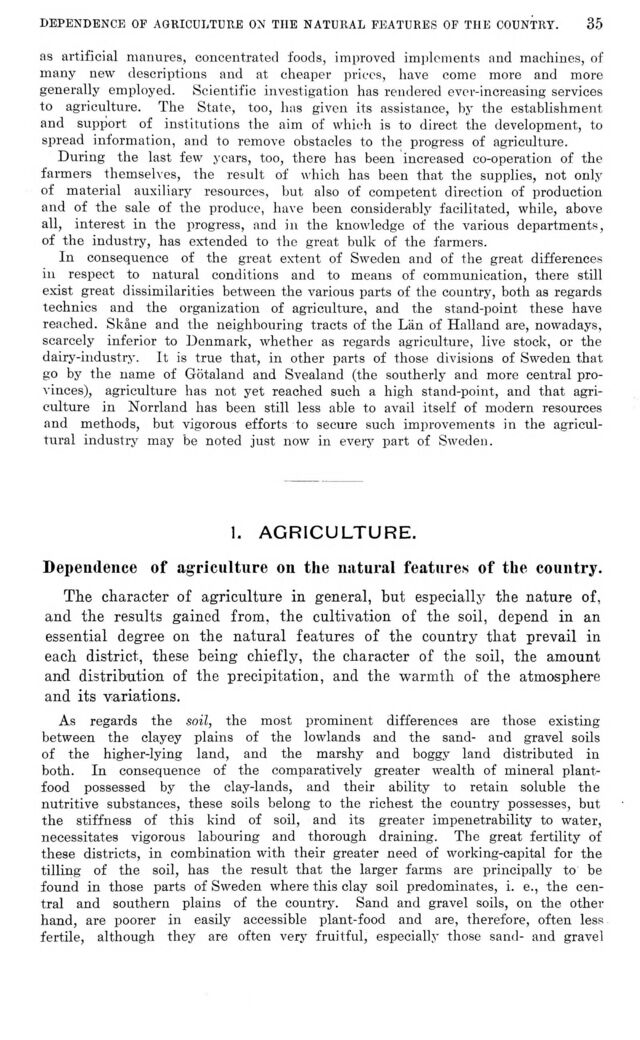
Full resolution (JPEG) - On this page / på denna sida - III. Rural Husbandry. Introd. by H. Juhlin Dannfelt - 1. Agriculture. By H. Juhlin Dannfelt

<< prev. page << föreg. sida << >> nästa sida >> next page >>
Below is the raw OCR text
from the above scanned image.
Do you see an error? Proofread the page now!
Här nedan syns maskintolkade texten från faksimilbilden ovan.
Ser du något fel? Korrekturläs sidan nu!
This page has never been proofread. / Denna sida har aldrig korrekturlästs.
DEPENDENCE OF AGRICULTURE ON TI1E NATURAL FEATURES OF THE COUNTRY.
35
as artificial manures, concentrated foods, improved implements and machines, of
many new descriptions and at cheaper prices, have come more and more
generally employed. Scientific .investigation has rendered ever-increasing services
to agriculture. The State, too, has given its assistance, by the establishment
and support of institutions the aim of which is to direct the development, to
spread information, and to remove obstacles to the progress of agriculture.
During the last few years, too, there has been increased co-operation of the
farmers themselves, the result of which has been that the supplies, not only
of material auxiliary resources, but also of competent direction of production
and of the sale of the produce, have been considerably facilitated, while, above
all, interest in the progress, and in the knowledge of the various departments,
of the industry, has extended to the great bulk of the farmers.
In consequence of the great extent of Sweden and of the great differences
in respect to natural conditions and to means of communication, there still
exist great dissimilarities between the various parts of the country, both as regards
technics and the organization of agriculture, and the stand-point these have
reached. Skåne and the neighbouring tracts of the Län of Halland are, nowadays,
scarcely inferior to Denmark, whether as regards agriculture, live stock, or the
dairy-industry. It is true that, in other parts of those divisions of Sweden that
go by the name of Götaland and Svealand (the southerly and more central
provinces), agriculture has not yet reached such a high stand-point, and that
agriculture in Norrland has been still less able to avail itself of modern resources
and methods, but vigorous efforts to secure such improvements in the
agricultural industry may be noted just now in every part of Sweden.
1. AGRICULTURE.
Dependence of agriculture on the natural features of the country.
The character of agriculture in general, but especially the nature of,
and the results gained from, the cultivation of the soil, depend in an
essential degree on the natural features of the country that prevail in
each district, these being chiefly, the character of the soil, the amount
and distribution of the precipitation, and the warmth of the atmosphere
and its variations.
As regards the soil, the most prominent differences are those existing
between the clayey plains of the lowlands and the sand- and gravel soils
of the higher-lying land, and the marshy and boggy land distributed in
both. In consequence of the comparatively greater wealth of mineral
plant-food possessed by the clay-lands, and their ability to retain soluble the
nutritive substances, these soils belong to the richest the country possesses, but
the stiffness of this kind of soil, and its greater impenetrability to water,
necessitates vigorous labouring and thorough draining. The great fertility of
these districts, in combination with their greater need of working-capital for the
tilling of the soil, has the result that the larger farms are principally to be
found in those parts of Sweden where this clay soil predominates, i. e., the
central and southern plains of the country. Sand and gravel soils, on the other
hand, are poorer in easily accessible plant-food and are, therefore, often less
fertile, although they are often very fruitful, especially those sand- and gravel
<< prev. page << föreg. sida << >> nästa sida >> next page >>